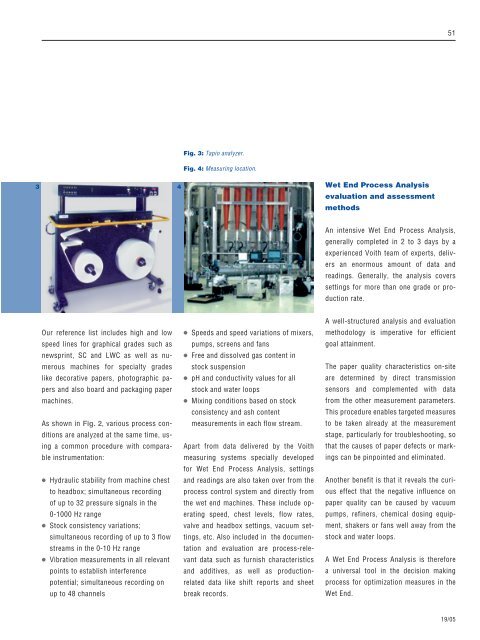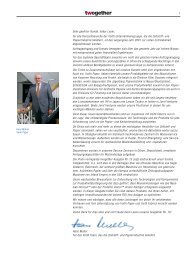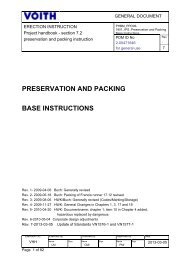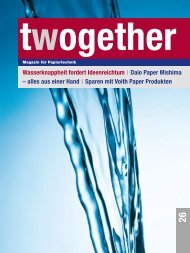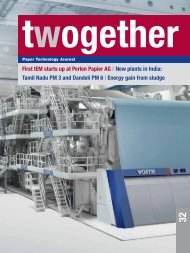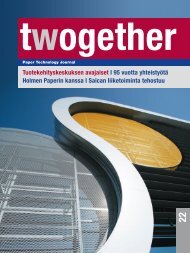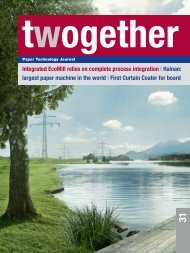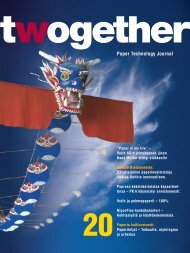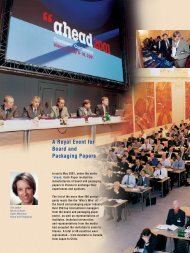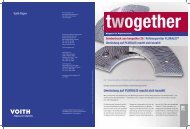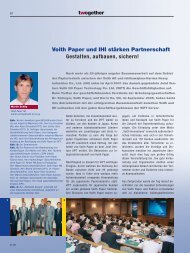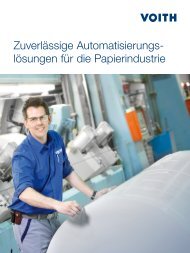Paper Technology Journal 19 - Voith
Paper Technology Journal 19 - Voith
Paper Technology Journal 19 - Voith
Create successful ePaper yourself
Turn your PDF publications into a flip-book with our unique Google optimized e-Paper software.
3 4<br />
Our reference list includes high and low<br />
speed lines for graphical grades such as<br />
newsprint, SC and LWC as well as numerous<br />
machines for specialty grades<br />
like decorative papers, photographic papers<br />
and also board and packaging paper<br />
machines.<br />
As shown in Fig. 2, various process conditions<br />
are analyzed at the same time, using<br />
a common procedure with comparable<br />
instrumentation:<br />
● Hydraulic stability from machine chest<br />
to headbox; simultaneous recording<br />
of up to 32 pressure signals in the<br />
0-1000 Hz range<br />
● Stock consistency variations;<br />
simultaneous recording of up to 3 flow<br />
streams in the 0-10 Hz range<br />
● Vibration measurements in all relevant<br />
points to establish interference<br />
potential; simultaneous recording on<br />
up to 48 channels<br />
Fig. 3: Tapio analyzer.<br />
Fig. 4: Measuring location.<br />
● Speeds and speed variations of mixers,<br />
pumps, screens and fans<br />
● Free and dissolved gas content in<br />
stock suspension<br />
● pH and conductivity values for all<br />
stock and water loops<br />
● Mixing conditions based on stock<br />
consistency and ash content<br />
measurements in each flow stream.<br />
Apart from data delivered by the <strong>Voith</strong><br />
measuring systems specially developed<br />
for Wet End Process Analysis, settings<br />
and readings are also taken over from the<br />
process control system and directly from<br />
the wet end machines. These include operating<br />
speed, chest levels, flow rates,<br />
valve and headbox settings, vacuum settings,<br />
etc. Also included in the documentation<br />
and evaluation are process-relevant<br />
data such as furnish characteristics<br />
and additives, as well as productionrelated<br />
data like shift reports and sheet<br />
break records.<br />
Wet End Process Analysis<br />
evaluation and assessment<br />
methods<br />
51<br />
An intensive Wet End Process Analysis,<br />
generally completed in 2 to 3 days by a<br />
experienced <strong>Voith</strong> team of experts, delivers<br />
an enormous amount of data and<br />
readings. Generally, the analysis covers<br />
settings for more than one grade or production<br />
rate.<br />
A well-structured analysis and evaluation<br />
methodology is imperative for efficient<br />
goal attainment.<br />
The paper quality characteristics on-site<br />
are determined by direct transmission<br />
sensors and complemented with data<br />
from the other measurement parameters.<br />
This procedure enables targeted measures<br />
to be taken already at the measurement<br />
stage, particularly for troubleshooting, so<br />
that the causes of paper defects or markings<br />
can be pinpointed and eliminated.<br />
Another benefit is that it reveals the curious<br />
effect that the negative influence on<br />
paper quality can be caused by vacuum<br />
pumps, refiners, chemical dosing equipment,<br />
shakers or fans well away from the<br />
stock and water loops.<br />
A Wet End Process Analysis is therefore<br />
a universal tool in the decision making<br />
process for optimization measures in the<br />
Wet End.<br />
<strong>19</strong>/05


